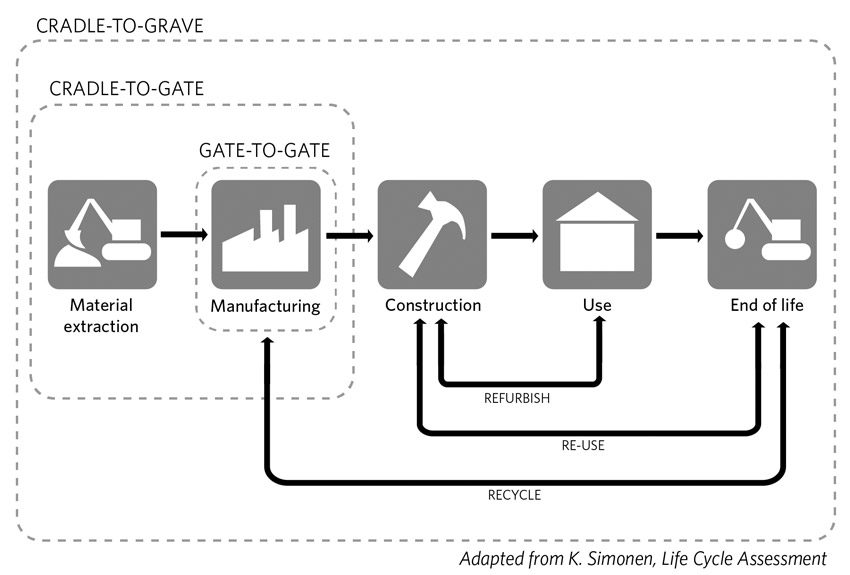Promoting Sustainable Design Through Life-Cycle Assessment Applications
Overview of LCA
As described in ISO14040:2006 Life-Cycle Assessment – Principles and Guidelines, LCA is “a systematic set of procedures for compiling and examining inputs and outputs of materials and energy and the associated environmental impacts directly attributable to the functioning of a product or service system throughout its life cycle.” This includes all stages from the time materials are extracted through manufacture, transportation, storage, use, recovery, reuse, and disposal.

Shown are the simplified life-cycle stages of a building.
This technique for assessing the potential environmental impacts associated with a product (or service) compiles an inventory of relevant inputs and outputs. We can think about inputs as ingredients or processes such as chemicals, energy, labor, water—everything that goes into the system. An output is something like mercury, methane, smoke, phthalates, or emissions. An environmental impact is measured according to potential environmental impact categories, such as global warming, acidification, eutrophication, smog formation, or human health impacts. The purpose of the LCA is to evaluate the potential environmental impacts associated with inputs and outputs and interpret the results of the inventory and impact phases in relation to the objectives of the study.
LCA is part of a larger framework of initiatives for reducing the environmental impact of buildings, which includes current standards such as Passive House, Living Building Challenge, and the 2030 Challenge. As energy codes become more stringent and operations-related environmental impacts drop, the demand for LCA results is increasing. Updated rating systems, such as LEEDv4, reward project teams that utilize whole-building LCA via a new Materials and Resources credit.
LCA analyzes the burdens throughout the entire building life cycle, quantifying the embodied environmental impacts of the building and its constituent materials. The quantitative data gleaned from LCA provides a basis by which architects and construction professionals can provide building owners with practical means and measures for initiating ecological building practices. As described by Kathrina Simonen in her book Life Cycle Assessment, “All building results in environmental impacts. … The challenge of developing truly sustainable or even regenerative buildings has led to a desire to understand building and construction from a systems-based perspective.” As Simonen adds, “Understanding a building or product from the perspective of its entire life cycle is the first step in developing sustainable and regenerative buildings.”
What Is LCA?
At its core, LCA is an in-depth, standardized analytical framework that allows for the quantification of environmental impacts and the comparison of design options. It is a means to study the environmental impacts on whole buildings, building products, and material assemblies. As previously mentioned, this valuable analysis calculates the direct and indirect inputs (such as energy and raw materials) and outputs (such as carbon dioxide and other pollutants) that result from a material or assembly’s manufacturing process, transportation, installation, use, maintenance, and disposal and translates those inputs and outputs into potential environmental impacts (such as global warming potential and smog).
By covering the whole life cycle of a material from the time the resources are extracted through end of use and disposal (“cradle to grave”), LCA can give a more complete picture of the total environmental impacts associated with the built environment.
Who Is Using LCA?
With environmentally responsible design becoming more prevalent in building construction, LCA is being used by architects, engineers, and contractors who want to take this awareness one step further. The deeper analysis that LCA offers allows designers to discover materials that minimize a project’s full environmental impact and evaluate the environmental consequences of specific design decisions. Additionally, because LCA can now be used to earn the LEEDv4 Building Life-Cycle Impact Reduction credit, it is increasingly being adopted or required by clients, architects, and engineers who are striving for LEED-certified buildings.
Benefits of LCA: What Can You Discover?
Building materials consume significant natural resources and energy in their manufacture and deployment. Though architects today are invested in reducing the energy used to operate buildings, few have the resources and expertise to deeply analyze the environmental impacts of their material choices. As energy efficiency becomes more and more crucial to the work of architecture—and energy codes become increasingly stringent—embodied carbon and other environmental impacts of building materials will become a proactively calculated and well-understood factor in reducing the total amount of resources buildings consume.
LCA results answer a multitude of questions that can inform material selection and major design decisions, especially when used early and often during the design process. Some examples of information that can be gleaned from an LCA include:
- Does the environmental impact of cross-country lumber transportation outweigh the environmental benefits of building a wood structure in this location?
- What are the major contributors to global warming potential in my building, and how can I reduce their impact?
- How many kilograms of carbon emissions can I save by increasing the substitute cementitious material (SCM) in my concrete mix?
- Which is less environmentally impactful if installed on my project: PIR foam insulation for XPS foam insulation?
Given the value of LCA, it is not surprising a need was identified for an automated, integrated, and streamlined LCA tool. Software products, particularly those that are Revit-integrated, have emerged to bring LCA to more users throughout the industry. BIM-integrated LCA is unique in that it allows for the generation of LCA data and feedback at every design phase, allowing users to take advantage of this early integration capability in order to answer questions like those noted above.









